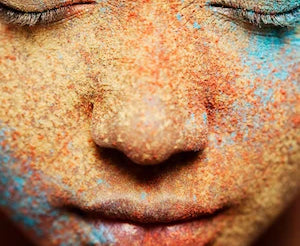Our skin contains melanin, which is the pigment that gives skin its color – high levels of melanin result in darker skin tones and low levels result in lighter skin tones. The pigment is produced by melanocyte cells in the skin. When melanin cells are damaged by environmental factors or become unhealthy due to disease or other circumstances, skin’s pigmentation can change in a variety of different ways. Here we will explore some of the most common skin hyperpigmentation disorders. 
Melasma is one of the most common skin pigmentation problems and is categorized by brown or gray-brown patches usually found on the face, specifically the central face, jawline, and cheekbones. It is most commonly found in women – 90% of all cases – and two main factors contribute to the formation: sun exposure and significant hormonal changes, such as those due to pregnancy or contraceptives.
Since melasma is spurred on by hormonal changes, its occurrence often cannot be avoided without fully avoiding the instigating factors. Having said that, it can clear up after a pregnancy, or after switching up contraceptives, or discontinuing their use altogether.
Although melasma is benign, many people still seek out expert advice for ways to reduce its appearance. Unfortunately, there isn’t an end-all-be-all treatment for melasma. However, topical creams can be used to help lighten the affected areas. In addition, chemical peels, dermabrasion, lasers and microdermabrasion can all be used to deeply target the area as these treatments strip away the top layers of the skin. Microneedling is also a great option, as it superficially damages the top layer of the skin making way for new skin cells to form and improve skin’s color and texture.
Post-inflammatory hyperpigmentation (PIH) is a skin pigmentation disorder that occurs following skin injury or inflammation, leaving skin temporarily darkened after the wound has healed. It appears as flat spots of discoloration and range in color from pink to red, and brown or black, depending on skin tone and the depth of injury. Darker skin tones are more prone to PIH as they have higher levels of melanin.
Skin problems that often result in PIH include acne, burns, eczema, allergic reactions, infection, insect bites, lichen planus, razor bumps, and psoriasis. When skin becomes inflamed or injured due to any of these problems, the human body naturally increases melanin production, which darkens and discolors the wounded area.
PIH does not cause scarring and even without treatment it will improve over time – this can take from a few months up to a couple of years, depending on skin type and severity of the injury. Fortunately for those wanting a quicker resolution, dermatological treatments such as chemical peels, microneedling, and laser therapy, as well as over-the-counter products – especially those with retinol, kojic acid, licorice root and vitamins – can improve the appearance and speed up recovery time.
Our final common skin pigmentation disorder is Solar Lentigo, commonly referred to as “age spots” or “liver spots.” Similar to melasma and PIH, it is a harmless darkening of the skin. Solar lentigo results from prolonged exposure to UV radiation, which causes production of melanocytes and accumulation of melanin over time.
Unlike freckles, which tend to fade during the winter months, solar lentigines are usually permanent, although certain treatments can reduce the appearance. Targeted cryotherapy, microneedling, IPL, and chemical peels are just some examples.
With all of the above, sun can aggravate and darken affected areas even further, prolonging the time it can take for pigmentation to fade, so it is important to utilize protection from the sun on the areas involved.







